
This page is only one of many thousands of Gotheborg.com Help and Information Pages, offering specialized knowledge on Chinese and Japanese Porcelain, including a Glossary, Q&A, Chinese and Japanese Porcelain Marks, Chinese Porcelain Exhibition and Excavation reports etc. For personal help and far more information, join our Discussion Board or use 'Ask a Question' for quick email consultations. For full text and better navigation, use a full-screen device rather than a mobile phone, that offers only limited content.
I do not collect "older" pieces, but would still love some information about 20th century pieces. I collect animal figures ie., parrots, ducks, chickens, roosters, dogs, etc. My favorite pieces are in the turquoise glazes or the multi-colored pieces (famille rose?) where each individual feather is painted a different color. I realize most of my pieces are after 1891 because they are marked "China". Here are some of my questions:
I have attached a couple of pictures and most certainly would appreciate any help you can offer. I can't seem to find any information on these "newer" pieces. Thank You.
First of all I would like to thank you for bringing up the subject. This area of let us say the last 100 years is very little studied. I guess it is because we usually could just ask our mothers when they bought whatever and that would be it. But, sooner or later our parents will not be around and it is time we get started sorting these pieces up.
But, again, there is no easy way to do this, one of the best ways is as I see it to continue to collect and let the pieces sort themselves up in your mind. I will give you some clues to help you along the way, though.
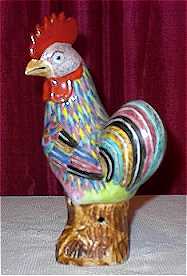 First of all, soft enamels of the Famille Rose type, like the ones on your cockerel (I think it is a cockerel because it seems to have too much of a tail to be a hen, don't you think?) might be the oldest. The Famille Rose enamels goes back to the 1730s. What to look for here is if some of the enamels are of a bright, clear glaze so as you could see the porcelain through it. During the 19th century this was not the case - most enamels were mixed with a small amount of white enamel so as to give it a softer appearance. It gives the same impression as if you mix candy colors with cream and is very easy to see once you noticed it. I am sorry if I over-explaining this, but it is an important thing. Sometimes during the early 1920s they stop doing this on most pieces and started to use more clear transparent enamels. This occurs at the same time as they also start using a dry, crisp black enamel for the thin dividing lines between the enameled areas. A 19th century piece would use a dry, brown or reddish (sepia) enamel for these thin black lines. (An 18th century piece would use the same brownish enamel but would cover it with an extra coat of clear glaze to make it appear black.)
First of all, soft enamels of the Famille Rose type, like the ones on your cockerel (I think it is a cockerel because it seems to have too much of a tail to be a hen, don't you think?) might be the oldest. The Famille Rose enamels goes back to the 1730s. What to look for here is if some of the enamels are of a bright, clear glaze so as you could see the porcelain through it. During the 19th century this was not the case - most enamels were mixed with a small amount of white enamel so as to give it a softer appearance. It gives the same impression as if you mix candy colors with cream and is very easy to see once you noticed it. I am sorry if I over-explaining this, but it is an important thing. Sometimes during the early 1920s they stop doing this on most pieces and started to use more clear transparent enamels. This occurs at the same time as they also start using a dry, crisp black enamel for the thin dividing lines between the enameled areas. A 19th century piece would use a dry, brown or reddish (sepia) enamel for these thin black lines. (An 18th century piece would use the same brownish enamel but would cover it with an extra coat of clear glaze to make it appear black.)
Based on this I would be prepared to date your cockerel to the later half of the 19th century - but would be interested to know if it has a China-mark. The use of solid black enamel as on the birds tail is something that usually are seen as coming in around the turn of the century.
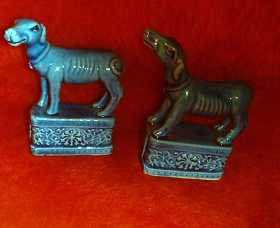 Colored glaze - like what it seems to have been used on your pigeon and the "sea dogs" are the latest on figures. Colored glaze is just the ordinary porcelain glaze with an extra addition of a coloring agent like cobalt (light to dark blue), copper (red), iron (black - brown all the way to celadon and yellow)
Colored glaze - like what it seems to have been used on your pigeon and the "sea dogs" are the latest on figures. Colored glaze is just the ordinary porcelain glaze with an extra addition of a coloring agent like cobalt (light to dark blue), copper (red), iron (black - brown all the way to celadon and yellow)
These colored glazes has in one way or another been in use for such a long time it is not the glaze that gives us a clue to its date but the porcelain body and shape only.
Of these two figures I would date both of them to possibly late 19th century from the decoration of the lotus decoration on the sided of their bases and their clumsy un-western like shapes. Had they been more modern, I would have assumed that they would have been more westernized and dog-like in their shapes.
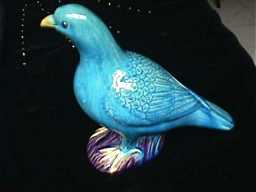
Copper red enamels are a chapter of their own, and are treated as such in the "Glossary" section of this site, and a subject I won't go into here since none of your pictures have one.
One dividing line is 1935 during the Japanese occupation, another is 1949 when they are starting to get a grip of their own on things. A third is in the 1970s after the "cultural revolution". If I may venture a guess here, I think that 1935 - they are artistically influenced by Japan and during the 1950s the influences comes from Russia.
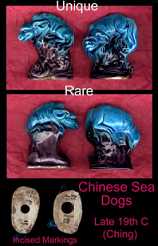 How to translate this into different designs - and tell the Chinese pieces apart from the Japanese pieces - is still to be decided, but after a glance at Japanese Netsukes I would say that the sea dogs do have more than a touch of a Japanese flavor in their general appearance. The Russian taste pieces are rather bombastic and heavily overdone by any western standard. Think of Late Victorian and then some.
How to translate this into different designs - and tell the Chinese pieces apart from the Japanese pieces - is still to be decided, but after a glance at Japanese Netsukes I would say that the sea dogs do have more than a touch of a Japanese flavor in their general appearance. The Russian taste pieces are rather bombastic and heavily overdone by any western standard. Think of Late Victorian and then some.
The porcelain body can also tell us something. My thought here is that most porcelain figures was made in one factory (The Sculpted Porcelain Factory, in Jingdezhen) and because of this, it is possibly to make a chronology.
Before 1949 they have told me, porcelain figures was molded in bisque fired pottery molds. After 1949 they started to use gypsum molds which soaks up water better and made it possibly to make lighter pieces, with thinner walls.
The better molds i.e. after 1949 reduced the necessity to scoop out porcelain clay from within the pieces before firing. As you know this must be done somehow to avoid cracking and warping during the firing. Before 1949 I think most pieces were "open" under, that is were resting directly on the base part of the walls. If this holds true we should therefore suspect that the "sea dogs" who got a base with a hole in can't be older than the 1950s.
Generally speaking we can assume that the more work that is done inside the piece, the older the piece. Came to think of it, weight is also an issue; It is the gypsum molds that makes it possibly to make light weight pieces and that started around 1950.
Regarding the color and look of 20th century China-marks I can only give you a rule of thumb. 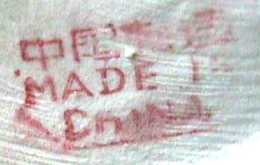 The general idea is, that they were most haphazardly applied during the troubled years of 1930-50. Before that, they were most often stamped in red and after 1950, stamped in underglaze blue or red depending on decoration. As an example of a very recent mark from the Peoples Republic of China (P.R.O.C.), I add a picture here from a figure I believe is made around 1950.
The general idea is, that they were most haphazardly applied during the troubled years of 1930-50. Before that, they were most often stamped in red and after 1950, stamped in underglaze blue or red depending on decoration. As an example of a very recent mark from the Peoples Republic of China (P.R.O.C.), I add a picture here from a figure I believe is made around 1950.
Regarding numbers, I think that could refer to the mold used or maybe the factory. It *could* be referring to a specific order though, but we'll have to figure that out when we find two similar pieces with different - or the same - number. As a preliminary guess I would place any numbered piece rather late in the history.
Regarding stamped or impressed marks, it might be that this is different depending on type of enamel. It is possibly that the red stamp enamel can't stand high temperatures and that they either had to chose between a paper label or an extra firing for just the China-mark if the glaze is of the high temperature type. By this we can assume that of two similar hard enameled monochromes the ones with paper label, no label or red stamp are older than pieces with impressed marks.
Sincerely,
Jan-Erik Nilsson
P.S. Dear visitor, If you happen to have a 20th century piece with a mark you know can estimate the date of, I would be most grateful if you would like to send a scan of that to me. I have now made a special section regarding 20th century marks and need as much information as possibly.